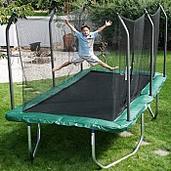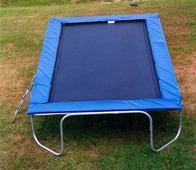Stitching Rows versus Thread Type:
Threading Issues: With trampolines there are 3 things I have too worry about with thread types. UV exposure, chemical breakdown (if in the hot sun like Florida and humid), & abrasion. UV treated Nylon thread used to be the one to get as it had the high tensile strength but now the chemtrails and the chemicals in the atmosphere and polluted water, most of the stitching in trampoline mats are made of polyheaster or teflon. Most companie use the polyheaster. They say its the "new nylon". It is much more UV and abrasion resistant and chemicals and sweat, it holds up more to that. The only con is that polyheaster is not as strong as nylon but its longevity is much longer and doesn't break down in the sun like nylon does. Nylon stitching's strenght is significantly reduced in the hot sun and UV.
Notice: Many companies use the nylon thread still. If you live in the hot sun, let me know on my quiz. They alll with this type of treading are strong at first but are the ones that seem to fall aprt the most in the long run.
Teflon is used on the most of the higher end trampolines. The price of Teflon thread is priced from 5-7 times that of polyheaster. Not many companies use the teflon unless requested or they already come standard with them. Most professional models already have teflon but many people request it custom. I don't recommend asking as you probably won't get a discount on a trampoline if they think you can afford make these upgrades.
Teflon is guaranteed to be resistant to UV. Teflon is the most abrasion resistant of all threading too. The only con is that it has the lowest tensile strength of all the threadings. But, it keeps whatever initial strength it initially has over a long time consistently over time. The best approach is to use polyheaster and Teflon together in the stitching. Its a more laboring process but it will keep its strenght longer and is able to carry more initial strength.
Take the Trampoline Quiz based on your needs
...because they all said they have the best quality and bounce
1-877-336-7890
Open from
8am till 10pm
Rectangle-Trampolines-Reviewed.com
1-877-336-7890
Open from
8am till 10pm




